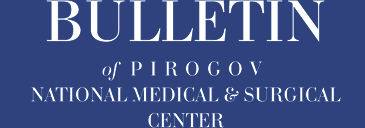Authors
Uzunyan D.G., Kislitsyna N.M., Sorokoletov G.V., Sokolovskaya T.V., Magomedova H.N., Sultanova D.M.
The S. Fyodorov Eye Microsurgery Federal State Institution, Moscow
Abstract
Relevance. Diagnosis and visualization of the anterior segment in IOL dislocation is fundamental in choosing the most effective method of repositioning dislocated IOL, ultrasound biomicroscopy (UBM) is practically the only highly informative method that allows non-invasive visualization of the pre-equatorial zone of the eyeball in vivo.
Goal. To evaluate the dynamic position of the IOL using the UBM method in patients with IOL dislocation.
Materials and methods. The study included 12 patients (12 eyes) with a diagnosis of grade 2.3 IOL dislocation and secondary uncompensated glaucoma. Grade 2 dislocation was detected in 41.6% of patients (5 eyes), grade 3 dislocation in 58.4% of patients (7 eyes). In order to assess the dynamic position of the IOL, all patients underwent an additional diagnostic examination, which included performing UBM axial scanning in the horizontal and vertical meridians in the “sitting” and “lying” positions of the subject. The statistical analysis was performed using the StatTech v. 4.8.11 software (developed by Stattech LLC, Russia).
Results. IOL contact with uveal structures in the “lying” position was observed in 16.7% of cases (2 eyes), while in the “sitting” position, IOL contact with uveal structures was observed in 100% of cases (12 eyes). According to the data obtained, when performing UBM in the “lying” position of the subject in comparison with the “sitting” position of the subject, there is a deepening of the anterior chamber, an increase in the CPC, and a posterior displacement of the IOL, therefore, the possibility of assessing the dynamic position of the IOL when performing UBM in the horizontal and vertical positions of the subject makes it possible to more reliably assess the nature of changes in the anterior segment of the eye.
Conclusion. The use of UBM in various positions of the patient’s body makes it possible to identify significant changes in the position of the intraocular lens and clarify the mechanisms of development of postoperative complications.
Keywords: IOL dislocation; ultrasound biomicroscopy; dynamic assessment of IOL position.
References
1. Kristianslund O, Dalby M, Drolsum L. Late in-the-bag intraocular lens dislocation. J Cataract Refract Surg. 2021 Jul 1;47(7):942-954. doi: 10.1097/j.jcrs.0000000000000605.
2. Belonozhenko Ya. V., Sorokin E. L. Clinical variants of postoperative dislocation of intraocular lenses, their frequency, and the risk of intraocular complications // TMZh. 2021. No. 3 (85). doi.org/10.34215/1609-1175-2021-3-32-34.
3. Kim SS, Smiddy WE, Feuer W, Shi W. Management of dislocated intraocular lenses. Ophthalmology. 2008 Oct;115(10):1699-704. doi: 10.1016/j.ophtha.2008.04.016.
4. Wang F, Yu Z, Xue S, Wang Y, Li L, Wang D, Wang L. Differences Between Angle Configurations in Different Body Positions by Ultrasound Biomicroscopy in Patients with Cortical Age-Related Cataract. Clin Interv Aging. 2023 May 15;18:799-808. doi: 10.2147/CIA.S408798.
5. Wu N, Zhang H, Chen B, Ding W. A novel application of B-ultrasonography at various head positions in the diagnosis of untypical uveitis-glaucoma-hyphema (UGH) syndrome: A case report. Medicine (Baltimore). 2019 Jan;98(2):e13891. doi: 10.1097/MD.0000000000013891.
6. Malyugin B.E., Uzunyan D.G., Semakina A.S., Panteleev E.N., Khapaeva L.L. “Method for Assessing the Dynamic Position of an Intraocular Lens” RU 2698365 C1, 26.08.2019.


